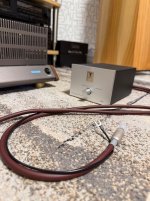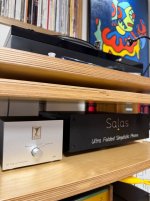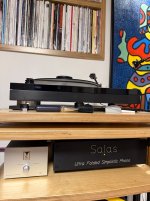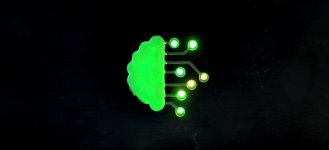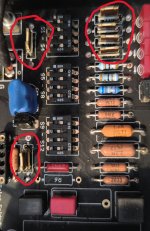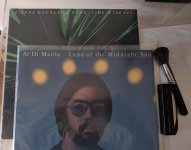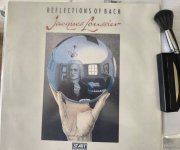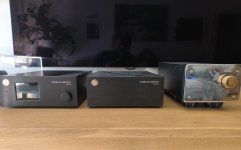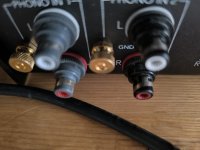Hi everyone. I have a question about the signal path resistors. I have the notion to mount signal resistors flush to the board, while leaving the others some gap to dissipate heat.
If that is a good way to approach it, am I correct that all rhe signal path resistor are R1, R2, R3, R4, R5, R8, R10, R11, R12, R13, R14, R15, R21, and R22?
If that is a good way to approach it, am I correct that all rhe signal path resistor are R1, R2, R3, R4, R5, R8, R10, R11, R12, R13, R14, R15, R21, and R22?
Last edited:
R1 shunting all load selection resistors and R17 RIAA base are the most influential in the path, the others are peripheral.
Can i lower R2, R2 a bit to get more gain, from 3.9 Ohm to 1.8 Ohm. This without getting a lot of distortion/noise ?
Ufsp is really special,so I decided to explore how it sounds with a very good step up transformer in front of it.so,I decided to go the Japanese way with Kondo audio note SFz,which is adjustable to 34 and 20 db gain.My cartridge is Dynavector xv1t,which is 24 ohms with 0,35mv output.long story short,amazing combination.it seems I haven’t met ufsp ‘s limits,after so many years,still surprises me.A big Bravo to Salas.
Attachments
Hi Salas, Can I select 56Db gain for Hi MC (2mV)? {HANA EH – High Output} At the output I will have about 1,2V + DCG3 with 3x gain 🙂
Last edited:
On the DCG3 0.93V output ...I need more. I'm going to build Wolverine V5, for full power it needs 2,5VI use about 42db with a 2.2mv cart, with DCG-3 at 3x.
It would take 48dB in the phono and X5 in the line pre to max out the particular Wolverine power amp with the high MC type Hana cart. That's at 0dB modulation on vinyl (5cm/sec). Since there are program peaks too I would not push higher than 45dB for a 2mV cart.
In any case gain has to be allocated proportionally between phono and line not to eat too much overload margin in the phono.
In any case gain has to be allocated proportionally between phono and line not to eat too much overload margin in the phono.
The late great Mr. 20. I miss him a lot.

Tea-Bag, I'm so sorry and I have no doubt you miss this little darling. My Avatar is my first dog Maza who is now almost seventeen years old.The late great Mr. 20. I miss him a lot.
View attachment 1458717
I want her to live forever but our journey is slowly coming to an end and I don't even want to think about it.
When she's gone, her picture will be the avatar for as long as I'm alive and on this forum.
Hi folks, after about 100 hours of break-in ,1mV white noise at the output of the reverse RIAA, the sound has changed a lot. The UFSP is a preamp that you can adapt to your system with small component changes. The Miflex KPCU 1 capacitors brought out the texture and richness of the midrange with a significant improvement in the highs, the cymbals now breathe and have good sustain. a good example of this is J. Loussier's "Reflections of Bach" Partita In E Major.
The dynamic range can be seen in Pierre Moerlen's Gong "Time Is The Key" . Now I can hear the nuances in the soundstage very well, an example is on Al Di Meola's LP "Land of the Midnight Sun" Sarabande from Violin Sonata in B Minor where you can literally see Al moving the guitar from the microphone. For comparison, I have two other phono preamps. One is a Gold Note PH10 with additional power supply and an EAR 843P MC with NOS Telefunken 12ax7 tubes cryogenically treated and KPCU Miflex capacitors for interstage and output. It turned out that the UFSP is a world of its own, proven to be the most versatile for me, neither too warm nor artificial and dry, somewhere between the sound of the best tube and IC preamps.
The dynamic range can be seen in Pierre Moerlen's Gong "Time Is The Key" . Now I can hear the nuances in the soundstage very well, an example is on Al Di Meola's LP "Land of the Midnight Sun" Sarabande from Violin Sonata in B Minor where you can literally see Al moving the guitar from the microphone. For comparison, I have two other phono preamps. One is a Gold Note PH10 with additional power supply and an EAR 843P MC with NOS Telefunken 12ax7 tubes cryogenically treated and KPCU Miflex capacitors for interstage and output. It turned out that the UFSP is a world of its own, proven to be the most versatile for me, neither too warm nor artificial and dry, somewhere between the sound of the best tube and IC preamps.
Attachments
Hello fellow diyers, I want to start building the Salas Folded Simplistic RIAA boards that came from the GB in May 2020. Is there a guide for the special UBiB 1.3s shunt regulator? I've been looking for a couple of hours now and hope for help here.
Specifically I don't know if the LED string needs matching to a certain value and same for the three PF5102 JFETs.
Cheers
Specifically I don't know if the LED string needs matching to a certain value and same for the three PF5102 JFETs.
Cheers
Hi, those 270R source pin resistors degenerate the PF5102 JFETs enough to guarantee low mA bias. How many mA can be judged by mV/270 across those resistors legs. Its not critical to be matched per position but if you like you can measure IDSS and put closer ones to same positions of the two regs. No need to match the LEDs, they are there just to drop some voltage for J1's safety and to indicate there's operation.
- Home
- Source & Line
- Analogue Source
- Simplistic NJFET RIAA
